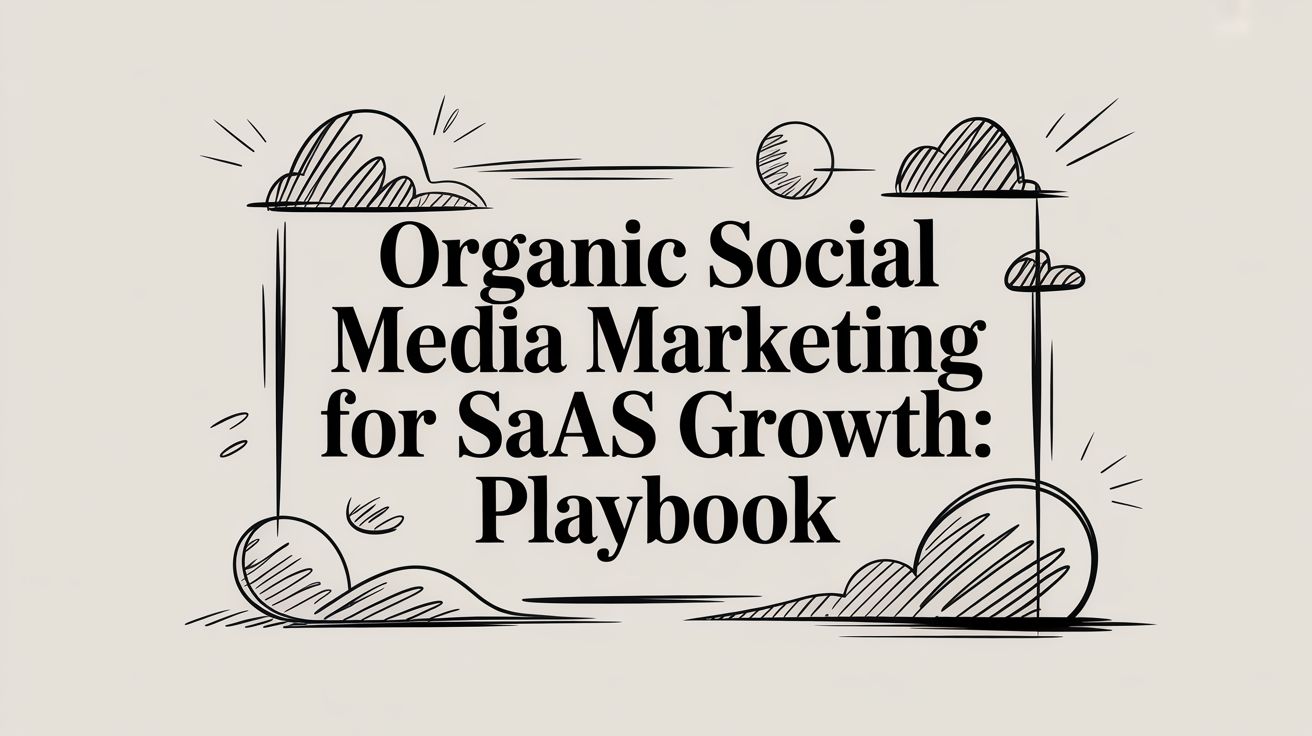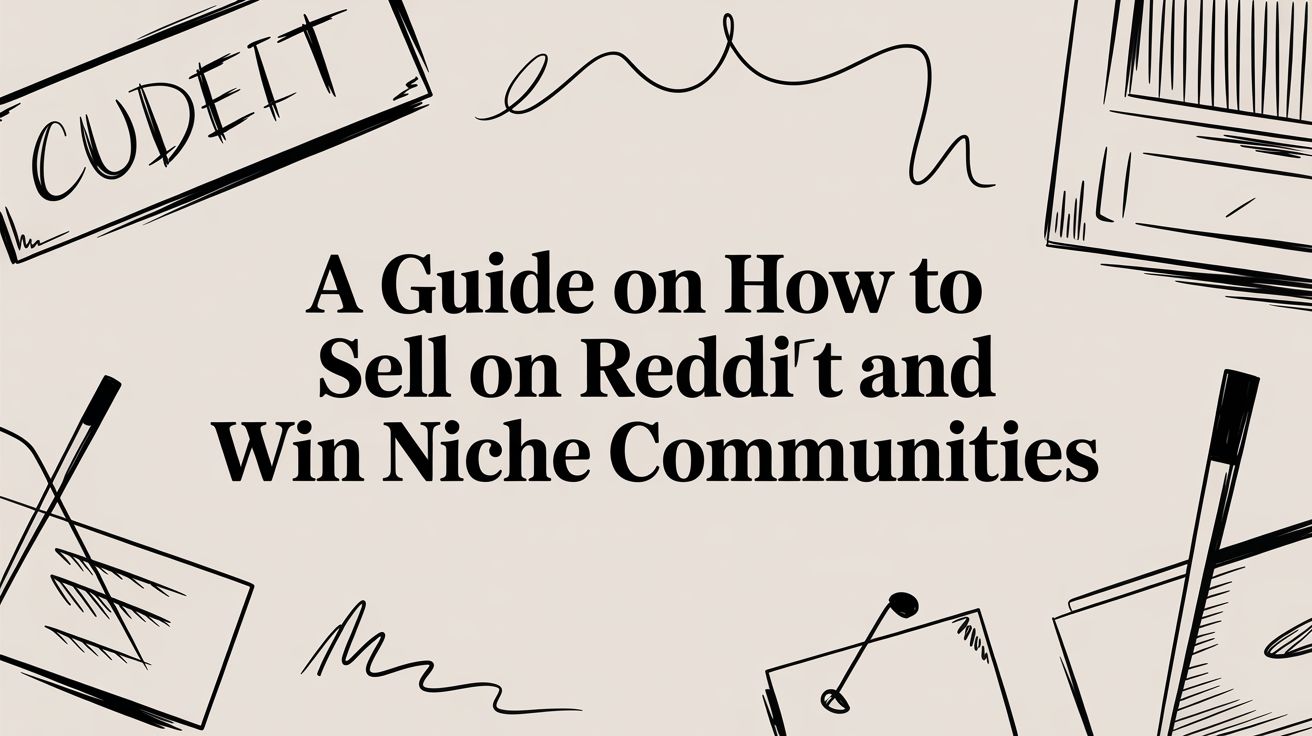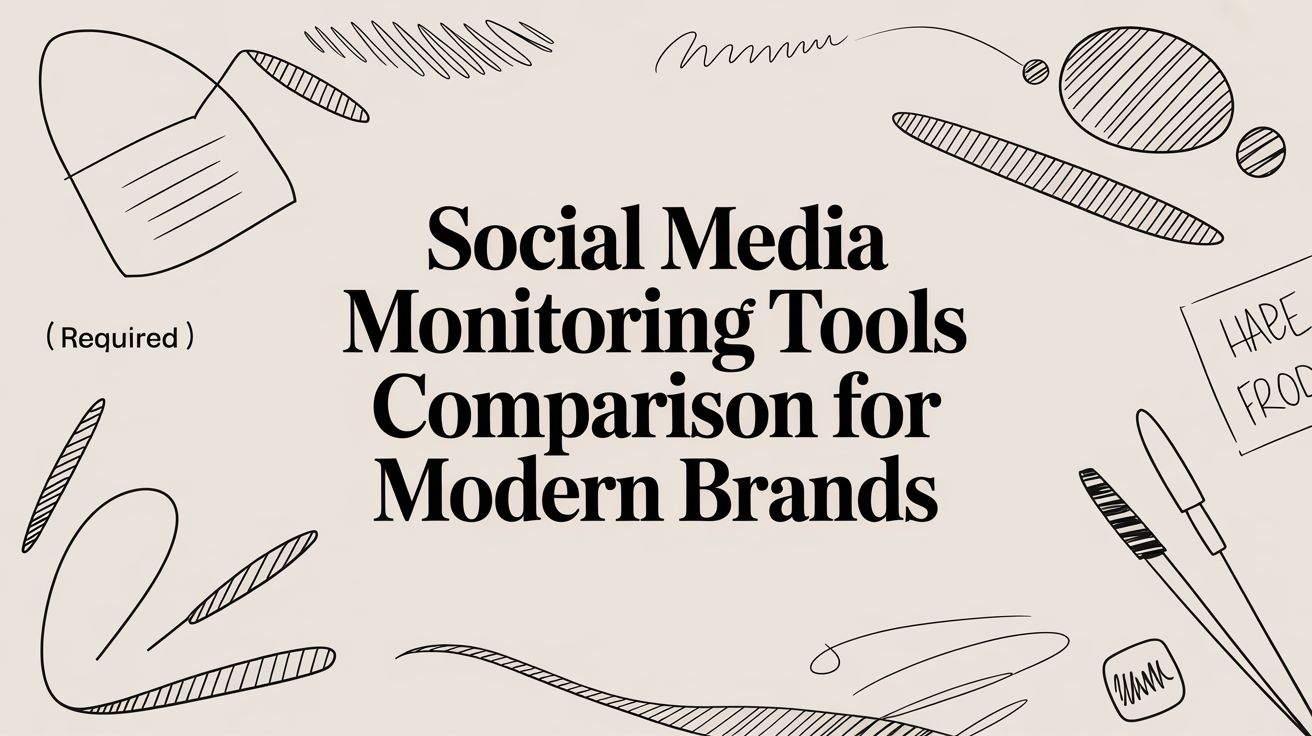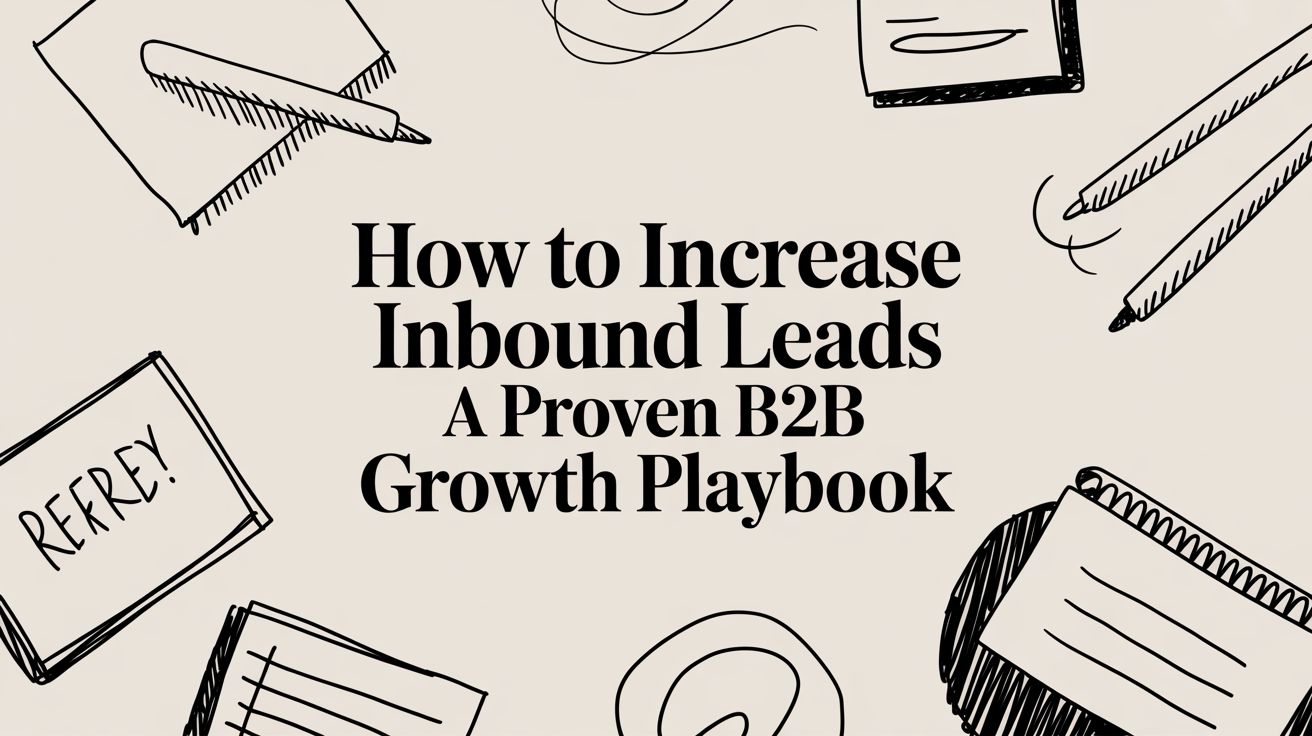Organic social media marketing is all about creating and sharing content on platforms like LinkedIn, X, and Reddit without paying to boost it. The real goal is to build authentic relationships and grow a community over time, not just chase the quick visibility you get from paid ads.
What Organic Social Media Marketing Really Means
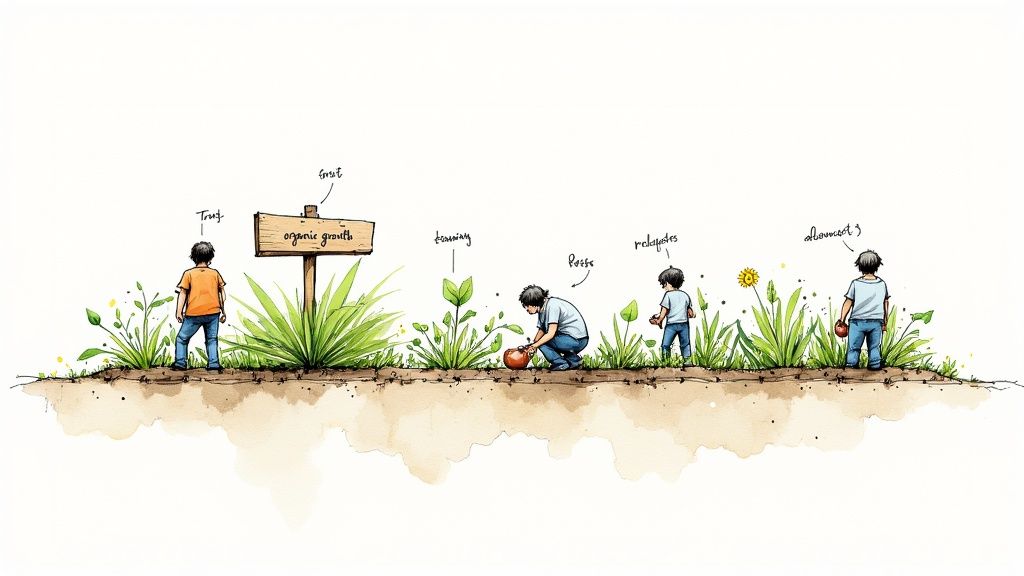
Let's cut through the jargon. Think of organic social media as tending to a community garden. It takes patience, consistent effort, and genuine care to grow something that actually thrives and gives back. You can't just toss some seeds on the ground and expect a full harvest the next day.
Paid social, on the other hand, is like buying produce at the supermarket. It's fast, predictable, and you get what you need right away. But it completely misses the deep connection and personal satisfaction you get from nurturing something yourself. Organic social is a long-term investment in trust, not just a free version of advertising.
Building Trust, Not Just Traffic
The heart of a great organic strategy is shifting your mindset from broadcasting to engaging. Instead of just shouting your marketing messages into the void, you're starting conversations, answering questions, and providing real value. That’s how you turn casual followers into genuine brand advocates.
This is especially critical for SaaS and B2B companies. Your sales cycles are longer, and big decisions hinge on reputation and trust, not impulse buys. A solid organic presence builds that trust long before a prospect even thinks about asking for a demo. It nurtures potential customers by positioning your brand as a helpful, credible authority in your field.
The goal of organic social media marketing isn't just to be seen; it's to be believed. Authenticity is your most valuable asset, creating a foundation that paid ads can amplify but never replace.
Why This Approach Resonates Today
This "show, don't tell" approach is more powerful than ever. People are tired of and skeptical of traditional advertising. Think about it: by 2025, about 65.7% of the global population will be on social media, juggling an average of 6.84 different platforms. To stand out, you have to cut through the noise with something real. For a deeper dive into specific strategies, this guide on Social Media Marketing for SaaS is a fantastic resource.
At the end of the day, organic social delivers sustainable growth because it creates a community where people feel seen, heard, and valued. This ecosystem becomes a powerful engine for your business.
- Customer Insights: You get direct feedback and unfiltered opinions that are gold for product development.
- Brand Loyalty: People who feel connected to your brand are far more likely to stick with you and recommend you to others.
- Compounding Returns: A strong organic presence keeps delivering value long after you post. A paid ad, however, stops working the second you turn it off.
Why Organic Is a Superpower for B2B and SaaS
For any B2B or SaaS company, organic social media isn't just another task on the marketing checklist—it's the engine for real, sustainable growth. Sure, paid ads can give you a quick sugar rush of visibility, but organic efforts build something far more valuable over time: genuine trust and deep-seated authority.
Think of it this way: paid ads are like a billboard on the highway, flashing a message to everyone who drives by. Organic is like being the go-to local expert everyone in town trusts for advice. When you're dealing with long sales cycles and complex products, that foundation of trust isn't just a nice bonus; it's everything.
Establish Unshakeable Authority
Let's be honest, B2B buyers are smart and they're skeptical. They’ve sat through countless sales pitches and can sniff out a thinly-veiled ad from a mile away. What they're actually looking for is real expertise that helps them solve a problem and look good doing their job.
Organic social media is the perfect place to prove you've got that expertise, without the awkward pressure of a sales call. You build credibility by consistently sharing valuable content that actually teaches something, sparks a real conversation, or offers a fresh perspective. This isn’t about shouting about your product's features; it’s about quietly proving you understand your customer’s world inside and out.
Here’s what that looks like in practice:
- Insightful Industry Reports: A SaaS company could drop a data-packed report on LinkedIn that breaks down industry trends with a unique, non-obvious analysis.
- Demystifying Complex Topics: A B2B service firm could use a thread on X to unpack a complicated process into simple, actionable steps, showing they're true masters of their craft.
- Answering Niche Questions: Your team can jump into specialized subreddits to answer very specific technical questions, positioning your brand as a genuinely helpful resource, not just a seller.
When you do this consistently, you build subject matter authority. Your brand becomes the first one that pops into a prospect's head when they're finally ready to make a purchase.
Generate High-Quality Leads
Organic social is also a fantastic magnet for high-quality leads. Unlike paid ads, which often feel like an interruption, your organic content attracts people who are actively looking for answers. They find you. This self-selection process means the leads you get are usually way more informed and genuinely interested in what you have to offer.
This is where the magic of "pull" marketing really shines. Instead of chasing people down, you create a resource so valuable that they come to you. You can dive deeper into building a predictable pipeline in our guide on how to generate B2B leads. The beauty of this approach is that by the time someone requests a demo, they already trust your brand and understand the value you bring to the table.
An organic lead isn't just a contact in your CRM; it's a relationship that has already begun. They've consumed your content, engaged with your ideas, and see your brand as a credible partner before the first sales conversation ever takes place.
Foster a Thriving Community
Finally, a strong organic presence doesn't just talk at an audience; it builds a community around your brand. This community quickly becomes one of your most valuable assets, giving you a direct line to your most passionate customers and biggest fans. It becomes a space for feedback, support, and connection that builds incredible loyalty.
An active community pays dividends in a few key ways:
- Real-Time Feedback: You get raw, unfiltered insights into what customers love, what they hate, and what they wish your product could do. This is gold for your product team.
- Increased Retention: Customers who feel like they're part of something are far less likely to churn. That sense of belonging is sticky.
- Powerful Social Proof: A bustling community of happy customers is the most authentic and convincing marketing you could ever ask for.
Ultimately, your social channels transform from being simple marketing bullhorns into living, breathing ecosystems. They become places where customers help each other out, share their wins, and cheerlead for your brand, creating a powerful, self-sustaining cycle of growth and loyalty.
Choosing Your Battlegrounds for Maximum Impact
Trying to be everywhere on social media is a surefire way to stretch your team thin and get zero results. A smart organic social strategy isn't about planting a flag on every platform; it’s about showing up in the right places, with a clear purpose. Each network is its own little world, with its own rules, user habits, and ways to win.
This is even more critical for B2B and SaaS startups. Your audience isn't just killing time—they're hunting for solutions, expert advice, and ways to get ahead in their careers. The trick is to match what you're great at with the platform where your ideal customers are actually listening.
Think of it like building a machine. You start with authority, which then generates leads, and those leads eventually become a loyal community that advocates for you.
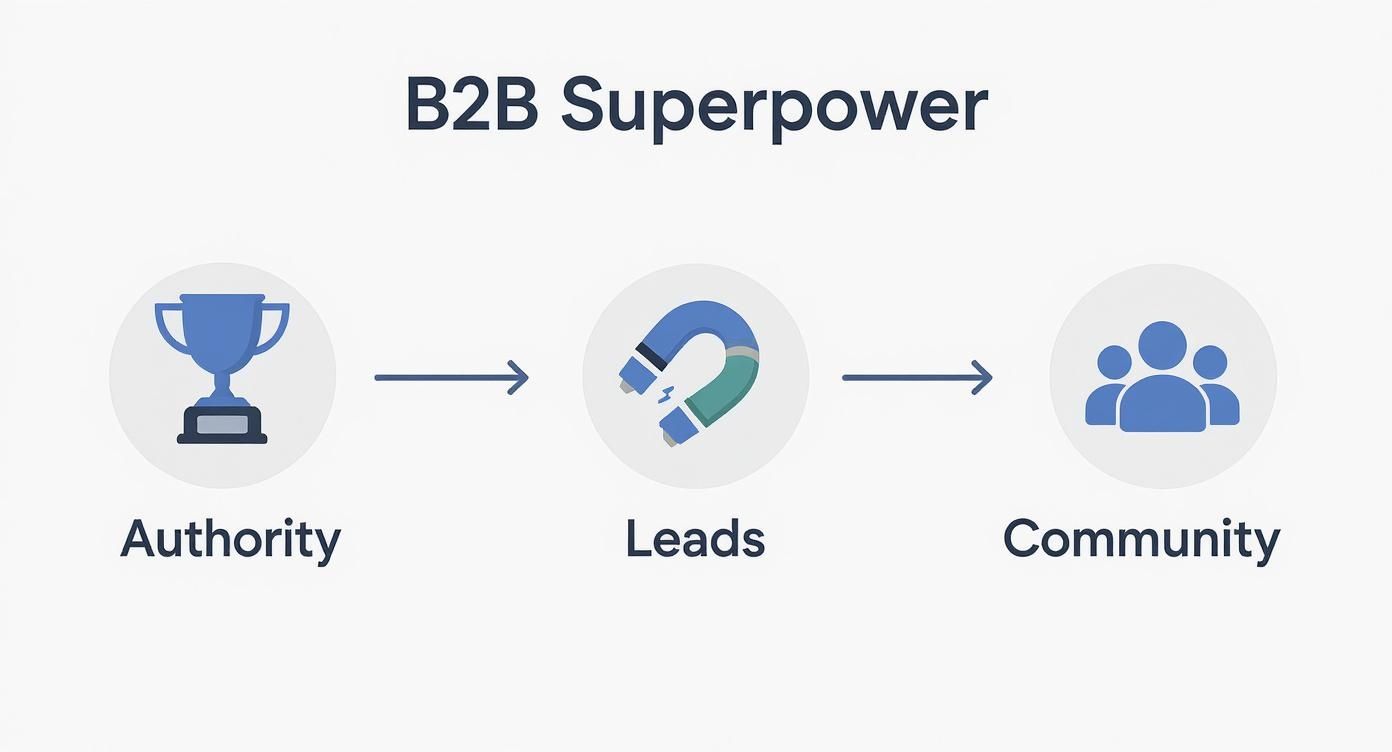
The map shows how establishing real authority is the first step. Everything else—qualified leads, a strong community—flows directly from that foundation.
To help you decide where to focus your efforts, let's compare the big three for B2B and SaaS.
Organic Social Media Channel Comparison for B2B/SaaS
| Platform | Primary Audience | Best Content Format | Key Organic Strategy |
|---|---|---|---|
| VPs, C-suite, Directors, ambitious professionals looking to network and learn. | Long-form posts, detailed articles, case studies, personal insights from founders. | Establish deep subject matter authority; become the go-to resource in your niche. | |
| X | Tech-savvy professionals, journalists, industry influencers, people seeking real-time news. | Short-form threads, quick stats, hot takes on industry news, engaging in conversations. | Build brand awareness and personality; stay top-of-mind by joining relevant conversations. |
| Niche specialists, developers, early adopters, candid users seeking authentic advice. | Genuinely helpful comments, answering questions, sharing non-promotional resources. | Listen and participate authentically; build trust by adding value without selling. |
Each of these platforms requires a completely different playbook. Let’s dive a little deeper into what makes each one tick.
LinkedIn: The Professional Powerhouse
Imagine LinkedIn as the industry’s most important conference. People are there to network, learn, and make career moves. This professional mindset makes it the perfect place to build real authority and connect directly with decision-makers.
Content that does well here has some meat on its bones. People will actually read something long if it teaches them something new or offers a fresh take on a problem they're facing. Nailing your approach here requires a solid understanding of social media marketing for startups and what resonates with a professional crowd.
Winning Content Formats for LinkedIn:
- Deep-Dive Articles: Share your expertise on specific industry challenges. Think of them as mini whitepapers.
- Case Studies & Customer Wins: Nothing builds trust like showing how you've helped others succeed in a professional setting.
- Founder-Led Thought Leadership: Posts from a founder or executive sharing personal insights on industry trends always hit differently and perform incredibly well.
On LinkedIn, don't just post—publish. Treat your company page and the profiles of your key team members like respected industry journals, not just online brochures.
X: The Real-Time Pulse
If LinkedIn is the formal conference, X (formerly Twitter) is the high-energy networking event happening in the lobby. It's all about quick takes, breaking news, and jumping into conversations as they happen.
To succeed on X, you need to be brief, clear, and consistent. It’s the perfect spot for dropping quick insights, adding your two cents to a trending industry topic, and letting your brand's personality shine. While leads can happen here, its real strength for B2B is building awareness. In fact, 73% of marketers see X as a key platform for just getting their name out there.
Winning Content Formats for X:
- Insightful Threads: Unpack a complex idea into a series of short, numbered posts. It’s a fantastic format for teaching and telling a story.
- Quick Stats and Data Points: A single, powerful statistic paired with a simple graphic can stop the scroll and provide instant value.
- Engaging with Industry Leaders: Don't just broadcast. Jump into conversations started by others to get on their radar and in front of their audience.
Reddit: The Authentic Community Hub
Reddit is a world away from the others. It’s not about who you know; it’s about what you’re into. The entire platform is built around communities (subreddits) dedicated to incredibly specific interests, and users there have a finely tuned radar for anything that smells like marketing.
For a SaaS company, Reddit is an absolute goldmine for listening. You can find subreddits dedicated to your industry, your target customer's job title, or even your competitors. The only rule is to participate, not promote. The goal is to become a trusted, helpful member of the community first.
Winning "Content" Formats for Reddit:
- Answering Questions: Find relevant subreddits and just answer questions with your expertise. No sales pitch, just genuine help.
- Sharing Resources (Carefully): If you have a blog post that perfectly solves a problem being discussed, you can share it—but always be upfront that it's yours.
- Gathering Feedback: Jump into discussions to understand what really bothers your potential users. It's the most unfiltered market research you'll ever get.
Authentic Engagement Tactics That Actually Build Community

If you want your organic social media to actually work, you need to stop chasing likes. Real success comes from sparking conversations that turn passive followers into a real community. This means ditching the generic, one-size-fits-all tactics.
True engagement is a two-way street. It’s about listening as much as you talk, giving value without expecting an immediate sale, and treating every single comment as a chance to build a relationship. When you do that, you foster the kind of loyalty that no ad budget can ever buy.
Turn Your Customers into Your Best Marketers with UGC
One of the most potent tools you have for building a community is user-generated content (UGC). We're talking about any photos, videos, reviews, or testimonials created by your audience that feature your brand. It’s raw, it's trustworthy, and it’s the best social proof you could ask for.
Why does it work so well? Simple: it comes from real people. Research shows that UGC is seen as 8 times more effective than a typical influencer post because it’s a genuine, unfiltered endorsement. On top of that, ads featuring UGC can see a 50% lower cost-per-click and click-through rates four times higher than standard ads.
Here’s how to get the ball rolling:
- Launch a Branded Hashtag: Create a unique hashtag and encourage your customers to use it whenever they post about their experience with your product.
- Run a Contest or Giveaway: Offer an exciting prize for the best photo or video submission that shows your brand in action.
- Feature Customer Stories: Make your customers the heroes. Regularly repost their content on your official channels (always with permission!) to celebrate them.
This strategy not only fills your content calendar with authentic material but also makes your customers feel seen and appreciated, which tightens their bond with your brand.
Scale Authenticity with a Human Touch
As your community grows, a new problem emerges: keeping up with every comment and question becomes nearly impossible. Many companies turn to automation and bots, but that often backfires, making the brand feel cold and robotic. There’s a better way to scale.
A smarter strategy is to use a human-reply service. This model gives you the scale of a tech solution but with the genuine feel of a real person. Instead of canned bot responses, you have trained writers crafting personalized, thoughtful replies that perfectly match your brand’s voice.
A human-reply service ensures no conversation falls through the cracks. It proves you can grow your reach without sacrificing the one-on-one connections that built your community in the first place.
This approach lets you be present in more conversations across Reddit, X, and LinkedIn without burning out your internal team. Every interaction stays authentic, allowing you to keep building the trust that creates die-hard fans. If you’re trying to build that initial audience on a specific network, guides like how to grow Instagram organically can offer platform-specific tips.
By combining the power of UGC with a scalable, human-first approach to engagement, you create a vibrant community that doesn’t just support your brand—it actively helps it grow. That’s the real heart of a winning organic social media strategy.
Measuring What Matters for Organic Social Media
https://www.youtube.com/embed/0RAvd-ng8Ew
Trying to prove the ROI of organic social media can feel like trying to catch smoke. You know it’s there, you can feel its effect, but it’s hard to grab onto. The good news is, if you focus on the right metrics, you can absolutely trace its impact all the way to your bottom line.
Let's walk through how to track meaningful engagement, referral traffic, and lead quality, leaving those superficial popularity contests behind.
Moving Beyond Vanity Metrics
We've all been there. It's exciting to see follower counts and impressions climb, but those numbers are often just window dressing. They give you a warm, fuzzy feeling but rarely translate into actual product trials or sales.
Instead of chasing likes, it’s time to put your spotlight on the metrics that reveal genuine customer interest and intent. It's a simple but powerful shift.
- Vanity Metrics: Things like likes, raw follower count, and total impressions.
- Business Metrics: Numbers that matter, like engagement rate per follower, referral traffic from social, and the quality of leads coming in.
This shift means your reports will start telling a story about growth, not just online popularity.
The KPIs That Actually Count
For B2B and SaaS startups, there are three powerhouse KPIs that tie the conversations you’re having online directly to business outcomes. Tracking these anchors your entire strategy in tangible value.
- Engagement Rate per Follower: This isn't just about raw likes. You calculate it by dividing your total engagements by your follower count. It tells you how well your content is actually resonating with the audience you've built.
- Website Referral Traffic: Using your web analytics, you can see exactly how many people are clicking through from your social posts to your site. This directly links online chatter to on-site behavior.
- Lead Quality Score: This is where the magic happens. By scoring the leads that come from your social channels, you can see which conversations are bringing in high-value prospects who are more likely to move through your sales funnel.
"Engagement rate per follower is a much truer signal of audience connection than a simple like count could ever be. It shows you who's really listening."
Building a Simple Attribution Framework
Attribution for organic social can feel like a puzzle with half the pieces missing. But you don't need a complex, expensive system to get started. A simple framework using UTM parameters and your CRM is often all it takes to connect the dots.
Think of it as creating a clear paper trail from a single comment on a post all the way to a booked demo.
- Start by adding
utm_source,utm_medium, andutm_campaignto every single link you share on social media. - Make sure your forms capture these UTM values and pull them into your CRM when a new contact is created.
- Set up rules to assign lead scores based on the interactions tied to specific campaigns (e.g., a lead from your "new feature launch" campaign might get a higher score).
- From there, you can monitor how leads from different social sources progress through your deal stages.
This process turns what feels like random digital chatter into a concrete map of what’s working. Your stakeholders will love seeing exactly which Reddit thread or LinkedIn post drove the most qualified trials.
Tying Social Activities to Business Outcomes
With a solid attribution framework in place, you can finally connect your daily social activities to real revenue goals. Every link you track is like a small pipe feeding into your main reservoir of trial sign-ups.
Here’s a look at a typical tool stack to make this happen:
- Google Analytics: Your go-to for tracking referral traffic and analyzing what visitors do once they land on your site.
- HubSpot or Salesforce: The brain of the operation, where you capture lead data from forms and apply scoring rules.
- Dashboard Tools: Use something like Looker Studio or Databox to pull it all together and visualize your KPI trends.
Keeping these tools in sync is crucial. It gives you a single, unified view of your social media impact, which means less guesswork and more confident decisions about where to invest your time and energy.
A Practical Example: The Reddit AMA Workflow
Let's make this real. Imagine you're hosting an "Ask Me Anything" (AMA) on Reddit to discuss a common pain point your software solves.
- First, you plan the AMA and create a unique registration link for a free trial, tagging it with
utm_source=reddit,utm_medium=organic, andutm_campaign=ama-q3-launch. - During the AMA, you share this link.
- As people click and sign up, you watch the referral traffic spike in Google Analytics and see how long they stay on your site.
- Your CRM automatically captures the UTM tags for each new lead and assigns them a score based on the "ama-q3-launch" campaign.
- In your weekly marketing meeting, you can now show a clear report: "The Reddit AMA drove 50 new trials, and 10 of them have already reached the 'qualified' stage."
Want to dive even deeper into how these metrics can fill your pipeline? Check out our complete guide on social media for lead generation.
Key Takeaways for Reporting
To wrap it up, the goal is to stop reporting on fluff and start reporting on results.
- Choose metrics that map directly to your sales funnel.
- Focus intently on engagement rate, referral traffic, and lead quality.
- Keep your dashboards clean and simple, telling a clear story about what's driving growth.
Watch Out for These Common Organic Strategy Tripwires
Even the sharpest organic social media strategy can hit a snag. The key to navigating this world isn't just knowing the right moves, but also knowing which traps to sidestep. Avoiding these common mistakes will ensure you're actually building your brand, not accidentally tearing it down.
The most common error? Inconsistency. It's so simple, yet so many fall for it. A flurry of posts one week followed by radio silence the next sends a clear message: you're unreliable. Both your audience and the platform algorithms reward a steady, predictable presence. It builds trust.
The "One Size Fits All" Content Trap
This one is a classic. Treating every social platform as if it's just a different-colored version of the same thing is a recipe for failure. That deep, data-driven post that gets applause on LinkedIn will get scrolled past in a nanosecond on a fast-paced feed like X (formerly Twitter). A generic, copy-paste approach just screams that you don't get it.
Instead of broadcasting the same message everywhere, you have to adapt it to the room you're in.
- LinkedIn: Think professional insights, meaty case studies, and thought leadership that helps people get better at their jobs.
- X: Go for short, punchy updates. Jump into trending conversations. Share quick stats and hot takes.
- Reddit: Your mission here is to add genuine value. Find niche subreddits, answer questions, and join discussions—without even a hint of a sales pitch.
When you tailor your content, you show you respect the community's culture. That respect is the foundation of any successful organic social effort.
Shouting Sales Pitches into the Void
Want to lose your audience in record time? Make every post a sales pitch. If your feed is just a stream of "buy our product" messages, you're not building a community—you're just running a bunch of free, annoying ads. People log on to social media to connect, learn, and be entertained, not to get bombarded with sales talk.
The goal isn't to yell about your product's features. It's to solve your audience's problems so elegantly that they can't help but ask about your solution.
Try shifting your mindset to "help first, sell later." Your content mix should feel like it's 90% pure value—educational, insightful, maybe even a little entertaining—and only 10% promotional. This 90/10 rule builds massive credibility, making your audience far more open to hearing about your product when the time is right.
Finally, don't ignore the feedback. Comments, questions, and even the occasional complaint are pure gold. Ignoring them makes you look aloof and uncaring. Engage with everything. It proves you're listening and turns your social profile from a billboard into a real, two-way conversation.
Frequently Asked Questions
How Long Until We See Results from Organic Social?
This is the big question, isn't it? While you might see small wins like a jump in comments or shares within a few weeks, the real, meaningful results take time. Think of it like planting a tree, not flipping a switch.
For a steady stream of meaningful lead flow and genuine brand fans, you should plan on a 6–9 month runway. That’s the typical timeframe it takes to build enough trust and momentum to see a consistent impact on your pipeline.
"Organic growth is a journey of patience, not a sprint to the finish line."
Should Our Organic Strategy Replace Paid Social Ads?
Definitely not. They're two different tools for two different jobs, and they work best together. Organic social is your foundation—it's where you build credibility, connect with your audience, and prove you have something valuable to say.
Paid ads are the amplifier. You use them to push your best-performing organic content to a wider, more targeted audience. It’s a powerful one-two punch.
- Organic builds a loyal community through consistent, valuable conversations.
- Paid puts a megaphone to your proven content and campaigns.
- Combining them gives you the best of both worlds: trust and reach.
What Are the Essential Tools for Managing an Organic Strategy?
You don't need a massive, complicated tech stack to get started. A few smart choices will save you countless hours.
First, you need a solid scheduling platform. Something like Buffer or Hootsuite is perfect for planning and publishing your content without having to be online 24/7.
Next, you need to know what people are saying. Social listening tools like Brand24 or Mention are fantastic for this. They track keywords and mentions of your brand across the web, so you can jump into relevant conversations as they happen.
The right tools don't just save time—they keep your team agile and focused on what matters: the conversation.
Most teams also hook up a simple analytics dashboard. This could be the native analytics on each platform or a custom dashboard in Google Analytics to track referral traffic. The goal is to see what’s working without getting lost in spreadsheets.
Here's a simple, effective setup to start with:
- Buffer for all your scheduling and publishing.
- Brand24 to keep an eye on brand mentions and industry keywords.
- Native platform analytics to track post-level engagement and see what resonates.
This lean stack is all you need to get started. You can always add more specialized tools as your strategy grows and your needs change.
Ready to scale authentic engagement with real human replies? Check out Replymer.
